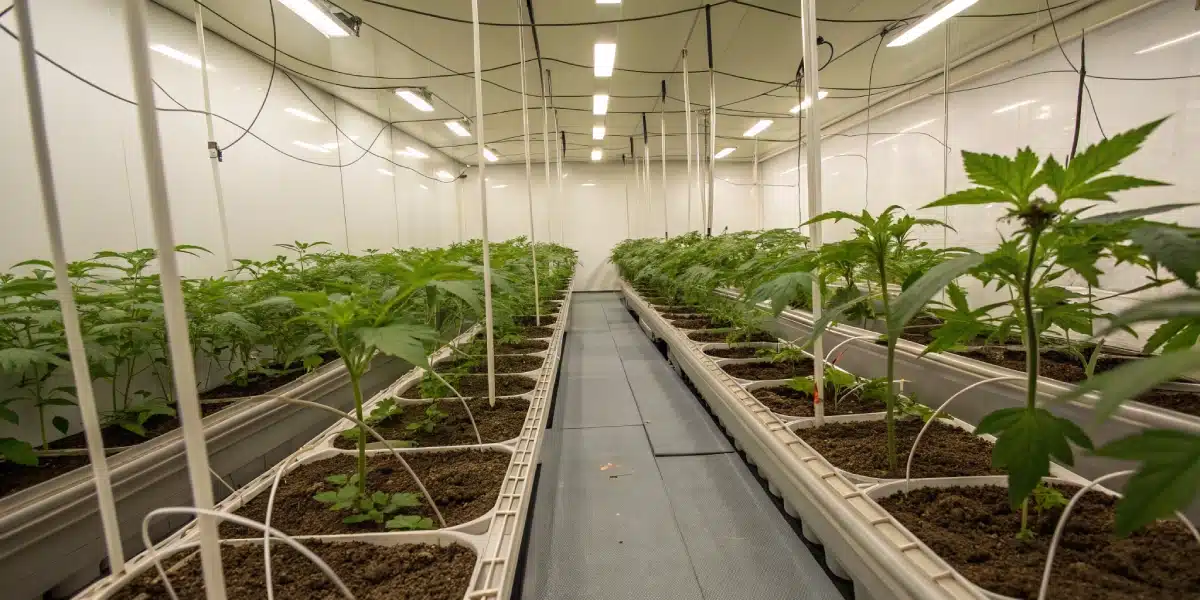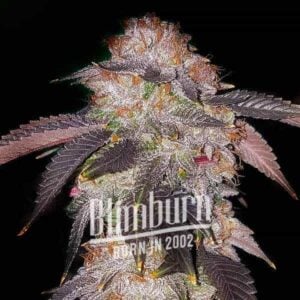White Truffle Weed Strain Cannabis Seed Description
The White Truffle weed strain, a popular truffle plant variety, is a luxurious and potent cannabis strain. It has won praise for its high quality and unique traits. This strain blends top genetics from classic lines. Its buds show deep purples and bright greens. They shine with a thick layer of trichomes. THC levels often exceed 25%. The aroma is a mix of sweet and spicy notes. Terpenes like caryophyllene, limonene, and myrcene add to its charm.
Growers love this strain because it grows evenly and gives high yields. It works well indoors and outdoors. Its resistance to common pests and diseases makes it ideal for all skill levels. In addition, White Truffle produces both uplifting mental effects and deep body relaxation. This balance makes it perfect for recreational and medicinal use.
Recommended Strains
White Truffle
 THC: 24% - 26%
THC: 24% - 26% Type of seed: Feminized
Type of seed: Feminized Phenotype: Mostly Indica
Phenotype: Mostly Indica Day to flower: 9 - 10 weeks
Day to flower: 9 - 10 weeks
White Amnesia
 THC: 18% - 22%
THC: 18% - 22% Type of seed: Feminized
Type of seed: Feminized Phenotype: Mostly Sativa
Phenotype: Mostly Sativa Day to flower: 8 - 10 weeks
Day to flower: 8 - 10 weeks
Promos & Deals
Environmental Requirements for Growing Marijuana White Truffle
The White Truffle strain grows best when conditions mimic its natural home. Keep daytime temperatures between 68°F and 79°F (20-26°C). Let temperatures drop slightly at night to boost growth. Start with 60–70% humidity during the vegetative stage. Then, lower humidity to 40–50% during flowering. This reduces mold and bud rot risks.
Lighting is very important. Use full-spectrum LED lights indoors because they are efficient and produce less heat. Outdoor growers should choose sunny, warm spots. Good ventilation and careful monitoring help the plants thrive. These simple steps improve overall plant health.
Setting Up The Growing Cannabis Space
A good grow setup is key for White Truffle. For indoor grows, choose a tent, closet, or dedicated room. Add reflective surfaces to boost light. Install a strong ventilation system to keep the air fresh. Use a nutrient-rich organic soil mix or try a hydroponic system for better control over nutrients.
Outdoor growers must pick a spot that gets plenty of sun and protects plants from heavy wind and rain. Use high-quality, well-draining soil. Support structures like trellises help the plants grow strong. This setup improves air flow and light penetration, which leads to better yields.
Propagation and Germination
Start by selecting high-quality White Truffle seeds from a trusted source. Soak the seeds in warm water or place them on a damp paper towel for 24–48 hours. This softens the seed coat and helps the taproot break through. Next, plant the seeds in a light, well-draining medium. Keep the environment steady at about 75°F (24°C) with moderate humidity.
Then, give the seedlings gentle, indirect light. Use a humidity dome to keep the moisture stable. Gradually expose the seedlings to stronger light as they grow their first true leaves. This careful transition helps them grow strong and prepares them for the next stage.
Vegetative Phase of White Truffle Weed
During the vegetative phase, White Truffle builds a strong framework. Use an 18-hour light cycle with full-spectrum light. Feed the plants with a nitrogen-rich fertilizer. Water only when the soil begins to dry. This practice helps the roots grow deep and avoids overwatering.
Next, shape the plants with training techniques. Topping creates a bushier plant with more colas. Low Stress Training (LST) gently bends branches for better light access. Prune weak or excess leaves to focus energy on bud sites. These steps help the plants grow evenly and prepare for flowering.

Flowering Phase of White Truffle Weed
Switch to a 12/12 light cycle to trigger flowering. Change to a fertilizer rich in phosphorus and potassium to support bud growth and resin production. Keep daytime temperatures between 65°F and 80°F (18-26°C). Lower humidity gradually to 40–50% to reduce mold risk. Monitor pH levels and adjust nutrient inputs as needed.
Control the environment closely. Ensure the plants have enough space to stretch. Use support structures if necessary. Watch the trichomes; a mix of milky and amber colors means it is time to harvest. Maintain a steady watering schedule and flush with plain water in the final weeks to improve flavor and purity.
Cannabis Fertilization and Nutrition
Nutrition is key for strong growth. Use a nitrogen-rich feed during the vegetative stage. Then, switch to a phosphorus and potassium mix during flowering. Add supplements like mycorrhizae or silica to boost plant health. Monitor soil pH and electrical conductivity regularly. This proactive approach prevents nutrient lockout and supports a high yield.
Pest And Disease Control for Cannabis Growing
Protect your White Truffle crop with good pest and disease management. Inspect your plants often and keep your grow space clean. Use natural predators and organic pesticides to fight pests. Maintain proper air flow and stable humidity to keep diseases at bay. Act quickly to remove any affected parts. These steps keep your plants healthy and boost overall quality.
Harvesting and Curing for Cannabis Growing
Harvest when the trichomes turn a mix of milky and amber. Use clean tools to trim the buds carefully. Dry the buds slowly in a dark, ventilated room. Keep temperatures between 60°F and 70°F and humidity at 50–60%. These steps preserve terpenes and cannabinoids.
After drying, cure the buds in airtight containers. Open the containers regularly during the first week to release moisture. This process improves flavor, smoothness, and overall quality. Careful harvesting and curing reward you with premium cannabis.
White Truffle Weed Strain: Indica or Sativa?
White Truffle blends traits of both Indica and Sativa. It offers a relaxing body high and a gentle, uplifting mental effect. This balance makes it suitable for both daytime and evening use. Its versatility appeals to a wide range of users. Whether you seek relaxation or creativity, White Truffle meets the need, offering a unique white truffle strain flavor that appeals to cannabis enthusiasts.
Advantages of Growing White Truffle Weed Strain Cannabis Seeds
Growing White Truffle offers many benefits. Its robust genetics ensure high yields and strong growth. Its unique flavor and high potency attract many consumers. The strain adapts well to various growing methods and environments. This makes it a good choice for both beginners and experts.
Moreover, its balanced effects and high THC create strong market demand. Growing this strain can be very rewarding for cultivators. It delivers a premium product that meets high standards.
Disadvantages of Growing White Truffle Weed Strain Cannabis Seeds
White Truffle also has some challenges. Its strong odor during flowering may require extra odor control. Its dense foliage calls for regular pruning and training to improve light penetration and air flow. These tasks can be time-consuming. However, careful management helps overcome these issues.
Some growers may also face nutrient imbalances and pest problems. By staying proactive and using proper techniques, you can manage these challenges. In the end, the effort leads to a high-quality, rewarding harvest.
Why Buy White Truffle Weed Strain Marijuana Seeds
Buying White Truffle seeds lets you grow a high-quality, potent strain. These seeds offer a unique genetic mix that promises excellent yields and distinct flavors. They work well for recreational and medicinal users. Many growers choose them for robust growth and balanced effects.
Purchasing from a reputable source guarantees premium genetics and consistent results. This investment supports a smooth cultivation process and a rewarding final product.
Problems in Cultivation this Strain Cannabis Seeds
Growers sometimes face issues with nutrient uptake, pest control, and environmental stress. Monitor conditions closely and adjust your care routine. Use integrated pest management and follow a strict nutrient schedule. These steps help you keep a steady, healthy crop. Proactive care leads to better harvests.
Soil Preparation for White Truffle Weed
Prepare your soil with a rich, well-draining mix. First, add compost or worm castings to boost fertility. Then, adjust the pH to between 6.0 and 7.0 to make nutrients available. This step supports strong root growth and prevents waterlogging. A good soil mix helps the plant grow robustly.
Watering Techniques for White Truffle Weed
Watering is key to healthy growth. Do not overwater, as that can harm the roots. Instead, let the top layer of soil dry out between waterings. This practice encourages deeper roots and better nutrient uptake. Adjust the watering schedule based on weather and plant stage. Proper watering keeps your plants happy.
Optimal Lighting for White Truffle Weed Cultivation
Lighting is very important for growth. Use high-quality full-spectrum lights like LED or HID systems indoors. Adjust the height and intensity to avoid burns and ensure even growth. Follow a consistent light cycle that suits the plant’s needs. Good lighting boosts photosynthesis and overall plant health.

Cloning White Truffle Weed: Pros and Cons
Cloning White Truffle allows you to replicate a strong mother plant. It saves time and ensures consistent genetics. However, it requires strict control over the environment. Clones may inherit issues from the mother plant, so watch them closely. When managed well, cloning can offer reliable, steady results.
FAQs about White Truffle Weed Strain
What makes White Truffle Weed strain unique?
White Truffle stands out for its rare genetics and unique flavor. It mixes sweet, spicy, and earthy notes. This strain offers both a relaxing body high and uplifting mental effects. Many users enjoy its balanced experience.
What are the ideal growing conditions for White Truffle Weed strain?
White Truffle grows best in controlled indoor settings. Keep temperatures between 68°F and 79°F. Use full-spectrum lights and maintain humidity at 60–70% in vegetative and 40–50% during flowering. Good ventilation and proper watering also boost growth.
How long is the flowering stage for White Truffle Weed strain?
The flowering stage usually lasts 8 to 10 weeks. Watch the trichomes and harvest when they show a mix of milky and amber colors. This timing helps ensure maximum potency and flavor.
What nutrient regimen is recommended for White Truffle Weed strain?
Start with a nitrogen-rich fertilizer during the vegetative phase. Switch to a mix high in phosphorus and potassium when flowering. Regularly check pH levels and flush the soil if needed. This routine supports healthy growth and resin production.
What common challenges may growers face with White Truffle Weed strain?
Growers may face temperature swings, nutrient imbalances, and pests. They should monitor plants often, adjust watering, and use integrated pest management. These steps help maintain healthy plants and maximize yield.


















